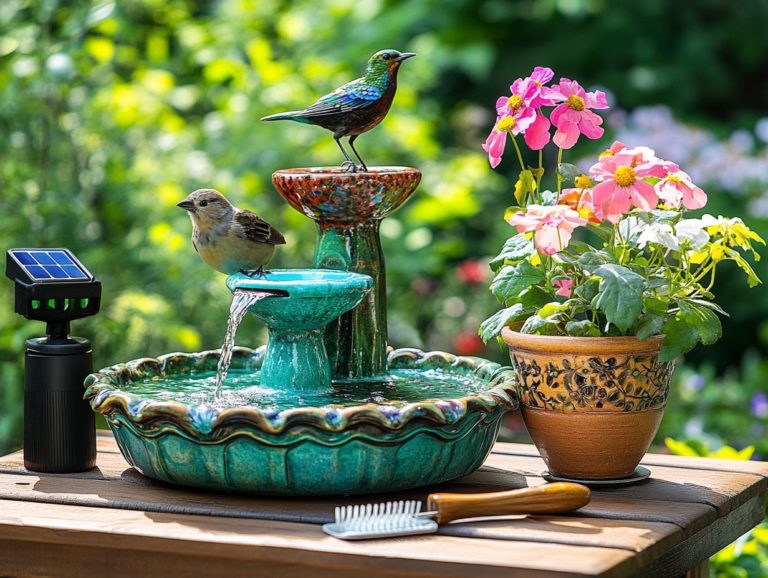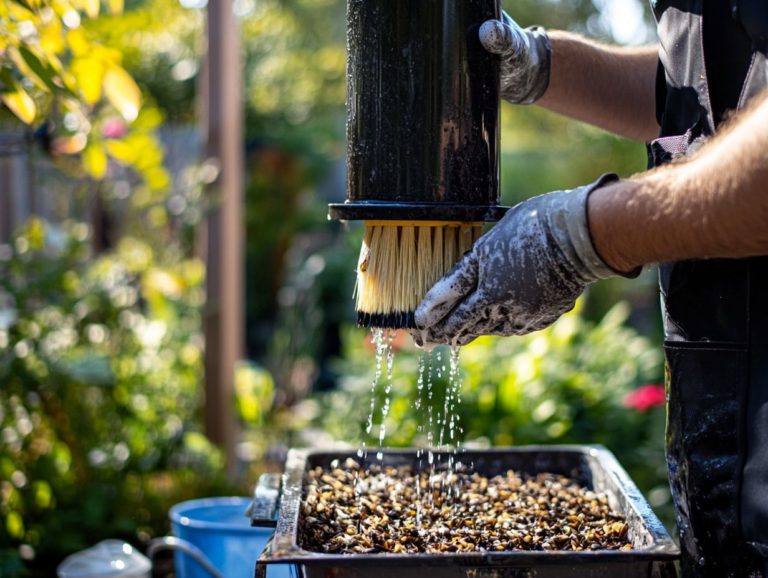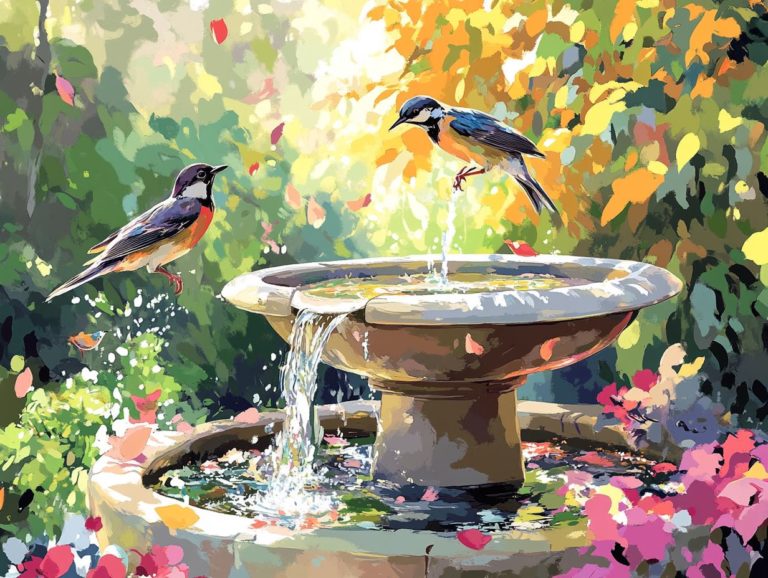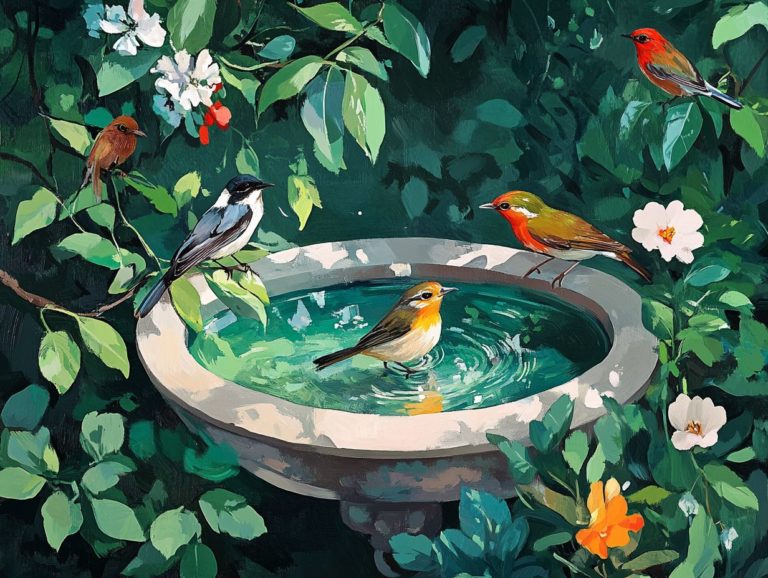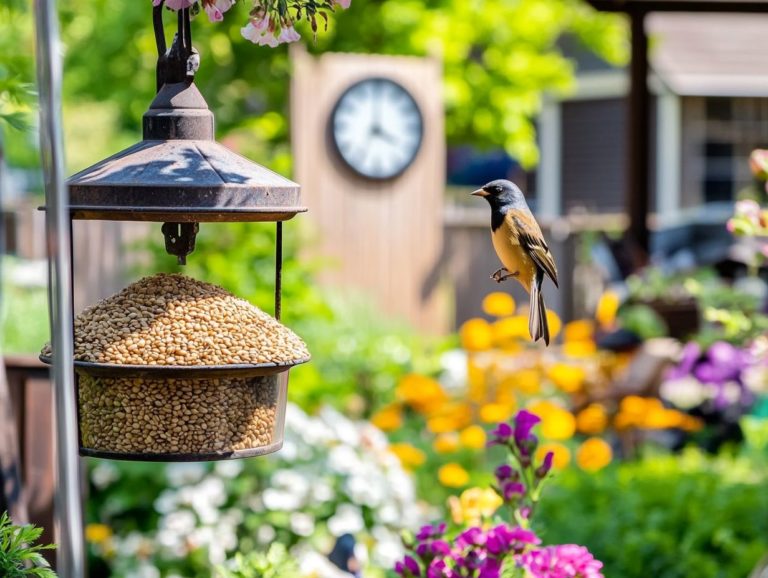Choosing the Right Bird Feeder for Your Area
Birdwatching has the power to transform your backyard into a vibrant sanctuary. Selecting the right bird feeder is crucial for attracting our feathered friends.
You ll want to consider everything from the ideal location and climate to the types of birds that frequent your area. It s a delightful puzzle to solve.
This guide will walk you through the various feeder types platform, hopper, suet, and tube and provide tips for enticing specific species such as cardinals and hummingbirds.
Also, pay attention to how often you need to clean the feeder to keep your feeders welcoming. Get ready to transform your birdwatching into an incredible adventure!
Contents
- Key Takeaways:
- Factors to Consider When Choosing a Bird Feeder
- Types of Bird Feeders
- Attracting Specific Bird Species
- Maintenance and Cleaning of Bird Feeders
- Frequently Asked Questions
- What factors should be considered when choosing the right bird feeder for my area?
- What type of feeder is best for attracting a variety of birds?
- How can I protect my bird feeder from squirrels?
- What is the best location for my bird feeder?
- What type of seeds should I use in my bird feeder?
- How often should I clean my bird feeder?
Key Takeaways:
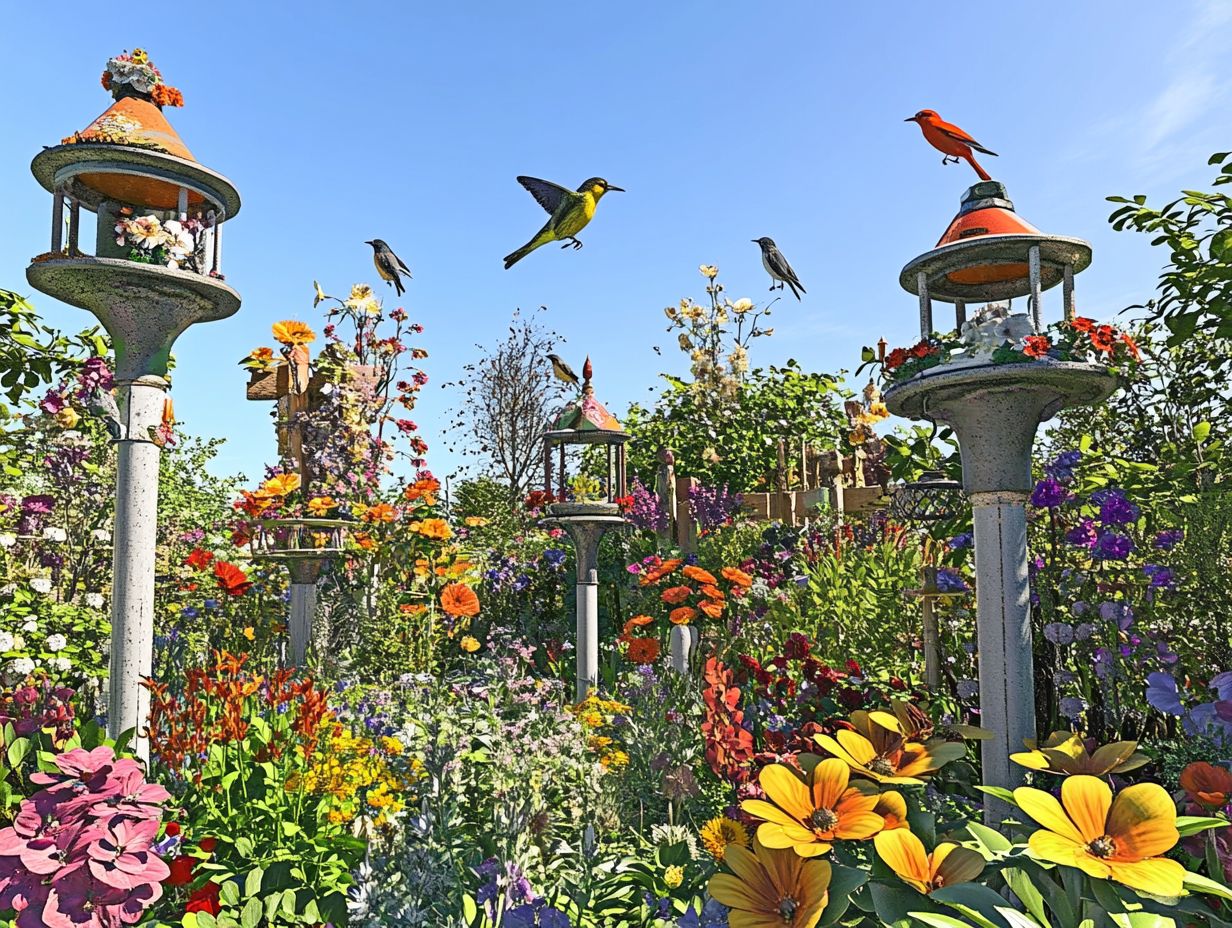
- Choose a bird feeder suitable for your climate and location to attract local bird species.
- Consider the type of bird feeder based on the birds you want to attract platform, hopper, suet, or tube feeders.
- Use specific tips for attracting certain bird species, like red feeders for cardinals or nectar feeders for hummingbirds.
Factors to Consider When Choosing a Bird Feeder
When choosing a bird feeder, it’s essential to consider several factors that will promote the health of the birds flocking to your backyard. Understanding choosing the right seed for your bird feeder can make a significant difference, as different feeders cater to certain types of birds and their unique feeding habits.
You’ll want to take into account your local climate, the types of food you plan to provide, and potential backyard pests like squirrels and raccoons that might interfere with feeding.
Also, don t overlook the maintenance needs and cleaning routines of the feeder. These elements are crucial for ensuring your feeding sanctuary remains a welcome and safe haven for your feathered visitors.
Location and Climate
The location and climate where you choose to set up your bird feeders play a crucial role in attracting the wild birds that will grace your backyard, so understanding bird feeder preferences can make a significant difference.
For instance, in colder climates, opting for feeders with a sheltering design like tube feeders that come with built-in perches can make a remarkable difference.
These designs not only safeguard seeds from snow and rain but also provide easy access for finches and chickadees in search of reliable food sources.
In contrast, if you’re in a temperate region with plenty of moisture, platforms or open trays can draw in species like jays and cardinals, which prefer foraging at ground level.
Additionally, local ecological factors such as surrounding vegetation and the availability of natural food sources will further influence which feeders will entice specific bird species to visit your setup regularly. For more information, check out the ultimate guide to bird feeder types.
Types of Birds in Your Area
Understanding the types of wild birds in your area is essential for selecting the right bird feeder and food to attract them effectively.
As you familiarize yourself with the local birds, you might spot energetic Pine Siskins flitting around feeders in lively flocks.
Striking Redpolls that can’t resist thistle seeds may also be around. Creating an inviting environment is key to your birdwatching success.
Evening Grosbeaks, with their vibrant yellow plumage, love sunflower seeds and are often seen at platform feeders.
Each species has unique feeding preferences; for example, Pine Siskins thrive on a tube feeder filled with thistle seeds, while Evening Grosbeaks appreciate larger feeders that can accommodate their more substantial appetites.
By tailoring your feeders to meet these specific dietary needs, including nyjer feeders for Pine Siskins and squirrel-proof feeders, you significantly enhance your chances of attracting a diverse array of feathery visitors.
Types of Bird Feeders
Bird feeders are available in a delightful array of styles and designs, each thoughtfully crafted to cater to specific types of food and entice a diverse assortment of wild birds. To complement your feeders, consider adding a bird bath; you can learn more about this in our guide on how to choose the right bird bath for your garden.
This variety not only enriches your backyard sanctuary but also elevates your birdwatching experience to new heights.
Start setting up your feeders today to welcome beautiful birds into your yard!
Platform Feeders
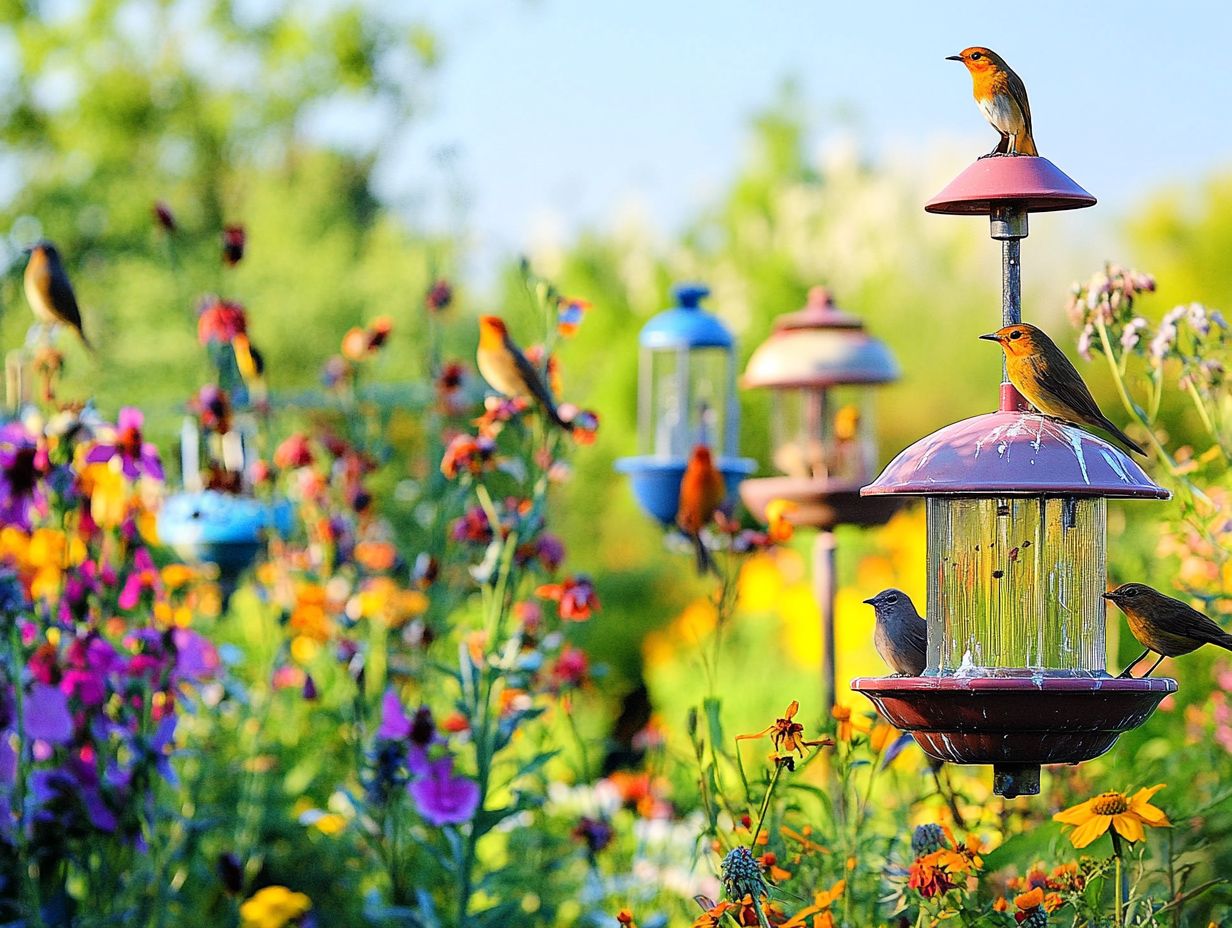
Platform feeders, often referred to as tray feeders, present a popular feeding solution. They allow multiple wild birds to gather and dine at the same time, making them a top choice for bird enthusiasts like you.
These feeders are crafted to accommodate a wide array of food options, from seeds and nuts to fruits and suet cakes. You’ll love seeing a delightful mix of bird species. Familiar visitors such as cardinals, finches, and jays will relish the easy access to their favorite snacks.
For the ultimate birdwatching experience, remember that placement is everything. Position your tray feeder near bushes or trees to provide birds with a sense of security from potential predators. Keep up with regular maintenance by cleaning the feeder and replenishing the food. This ensures a safe and inviting dining atmosphere for these enchanting creatures, transforming your backyard into a thriving wildlife sanctuary.
Hopper Feeders
Hopper feeders are expertly crafted to dispense birdseed slowly, providing a reliable feeding source for a variety of wild birds. They are especially effective when filled with sunflower seeds.
These feeders feature a protective roof and robust construction. This ensures that the seed remains dry while deterring larger animals from making a meal of it. For birdwatchers, hopper feeders offer a splendid opportunity to observe a delightful range of species, from charming sparrows to striking goldfinches.
The slow dispensing mechanism encourages birds to linger, allowing you to enjoy extended viewing sessions. Regular maintenance is essential to guarantee a steady supply of fresh seed and prevent mold growth. Expect a colorful gathering of birds such as chickadees and nuthatches flocking to these feeders, adding a touch of enchantment to your backyard.
Suet Feeders
Suet feeders are an exceptional option for attracting insect-eating birds, such as woodpeckers and nuthatches. They provide a high-energy food source that meets their dietary needs perfectly.
These feeders hold suet cakes, primarily composed of animal fat. They can be enhanced with seeds, fruits, or insects to entice various bird species. By offering an assortment of suet types like peanut butter-based varieties or those infused with mealworms you can attract not just woodpeckers and nuthatches, but also chickadees, jays, and even some warblers.
To encourage more frequent visits, position the feeders in a quiet, sheltered area, creating a sense of safety for your feathered friends. Using suet with different flavors tailored to the birds in your region can significantly amplify your chances of attracting a delightful array of avian visitors.
Tube Feeders
Tube feeders are a superb choice for offering small seeds, like those in nyjer feeders, perfectly suited for finches and other petite birds.
These feeders have gained popularity among bird enthusiasts for their ability to keep larger birds at bay, creating a serene haven for your delicate visitors. One standout feature is their innovative design, which minimizes seed waste, allowing birds to feed with impressive efficiency.
By practicing regular maintenance cleaning and refilling your feeders you ensure they remain inviting and healthy spaces for your avian guests. Tube feeders attract various species, including goldfinches, siskins, and chickadees, presenting an excellent opportunity for birdwatching enthusiasts.
Effectively managing leftover seeds keeps your yard tidy and encourages healthier feeding behaviors among small birds.
Attracting Specific Bird Species
If your aim is to entice specific bird species such as cardinals, hummingbirds, or woodpeckers, utilizing targeted feeding strategies is essential. Selecting the right types of bird feeders, like fruit feeders, can truly elevate your birdwatching experience. Don’t miss out on the chance to see a variety of birds in your backyard set up your feeders today!
Tips for Attracting Cardinals
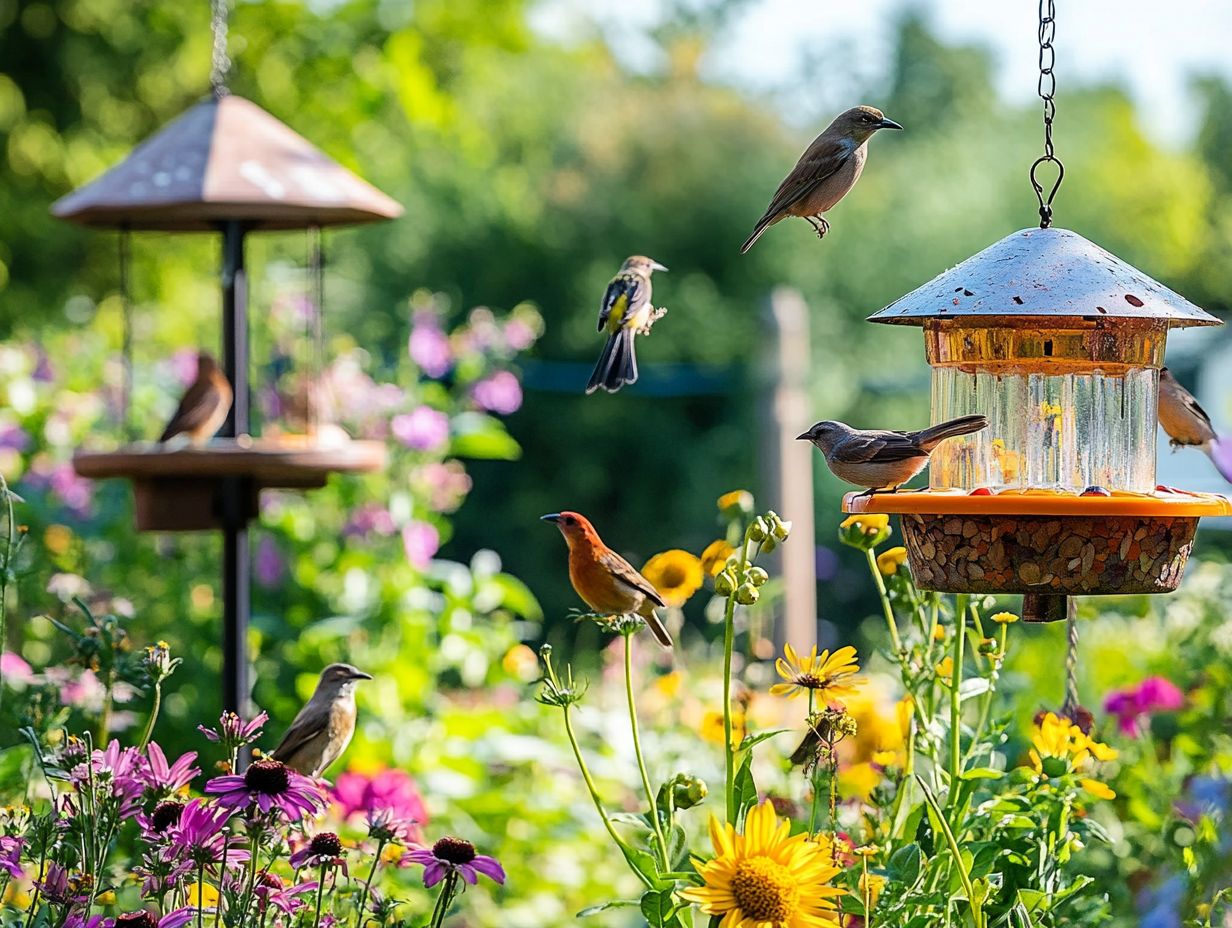
To attract cardinals, consider using fruit feeders and offering their preferred food sources, such as berries and sunflower seeds, in a spot that s easy for them to access.
Position your feeders near dense shrubs or trees to create a safe haven for the birds. This allows them to perch and keep an eye out for any potential threats from backyard pests while they dine.
Cardinals are naturally drawn to bright colors. They will eagerly visit vibrant feeders, making your yard a lively spot! Incorporating red or orange feeders can work wonders.
Keep the feeders clean and filled with fresh food regularly. These sociable birds often come in pairs or small groups, so a lively feeding environment will certainly catch their attention.
Understanding their preference for safe spaces and the surrounding vegetation can significantly boost your success in attracting these stunning songbirds, especially during National Bird-Feeding Month.
Attracting Hummingbirds with Feeders
Attracting hummingbirds is all about setting up specialized window feeders filled with a sugar-water solution that mimics their natural nectar sources. Set up your feeders now to catch the eye of these beautiful birds!
You have various feeder options at your disposal, including tube feeders, window feeders, and tray feeders. Each is thoughtfully designed to cater to different species and their unique feeding preferences. To create the perfect nectar, simply mix one part sugar with four parts water; this closely resembles what hummingbirds typically encounter in nature.
For optimal results, hang these feeders in shaded areas to prevent fermentation. Ideally, place them within view of flowering plants that can entice even more visitors.
Keep in mind the seasonal migration patterns; during spring and fall, adjust the locations of your feeders and ensure they are well-stocked. This can attract migratory birds passing through, including Pine Siskins and Redpolls.
Attracting Woodpeckers with Suet Feeders
To attract woodpeckers to your backyard, consider using suet feeders filled with high-fat suet. Suet is a high-fat food made from animal fat that provides energy for birds, particularly during the colder months, helping to support their overall health.
Place these feeders in a convenient, visible spot like near trees or sturdy posts. This significantly boosts your chances of drawing in a variety of woodpecker species. Red-bellied, downy, and hairy woodpeckers have a particular fondness for suet, so be sure to position the feeder at least five feet off the ground. This height helps them feel safe from ground predators.
Regularly checking and refilling the suet is key, especially during harsh weather. It not only keeps their energy levels high but also encourages more frequent visits. You might also think about using a suet blend that includes bits of nuts or fruit, making it suitable for various species such as nuthatches, catbirds, and goldfinches. This caters to different woodpecker preferences, ensuring an enticing feast that keeps these fascinating birds coming back for more.
Maintenance and Cleaning of Bird Feeders
Proper maintenance and regular cleaning of bird feeders are essential for creating a safe and welcoming haven for wild birds. By prioritizing these practices, you enhance their experience and contribute significantly to their overall health and well-being.
Importance of Regular Cleaning
Regularly cleaning your birdfeeders is essential to prevent the spread of disease among wild birds and to maintain a welcoming feeding sanctuary.
To keep your feeders clean and inviting for a variety of bird visitors, including hummingbirds and orioles, adopt a systematic approach. Start by emptying the feeder and rinsing it thoroughly with hot water and a mild soap solution. This cleaning routine should occur at least every two weeks to prevent mold and bacteria buildup, especially during wet weather that can attract pesky backyard pests like squirrels and raccoons.
Certain feeders, like those designed for hummingbirds, need more frequent attention due to the sticky sugary residue they attract. Using natural, non-toxic cleaning products benefits both the birds and the environment, ensuring a safe feeding space.
A clean feeder not only fosters a healthier habitat but also invites more birds to your area, enhancing your enjoyment as a nature enthusiast!
Proper Maintenance Techniques
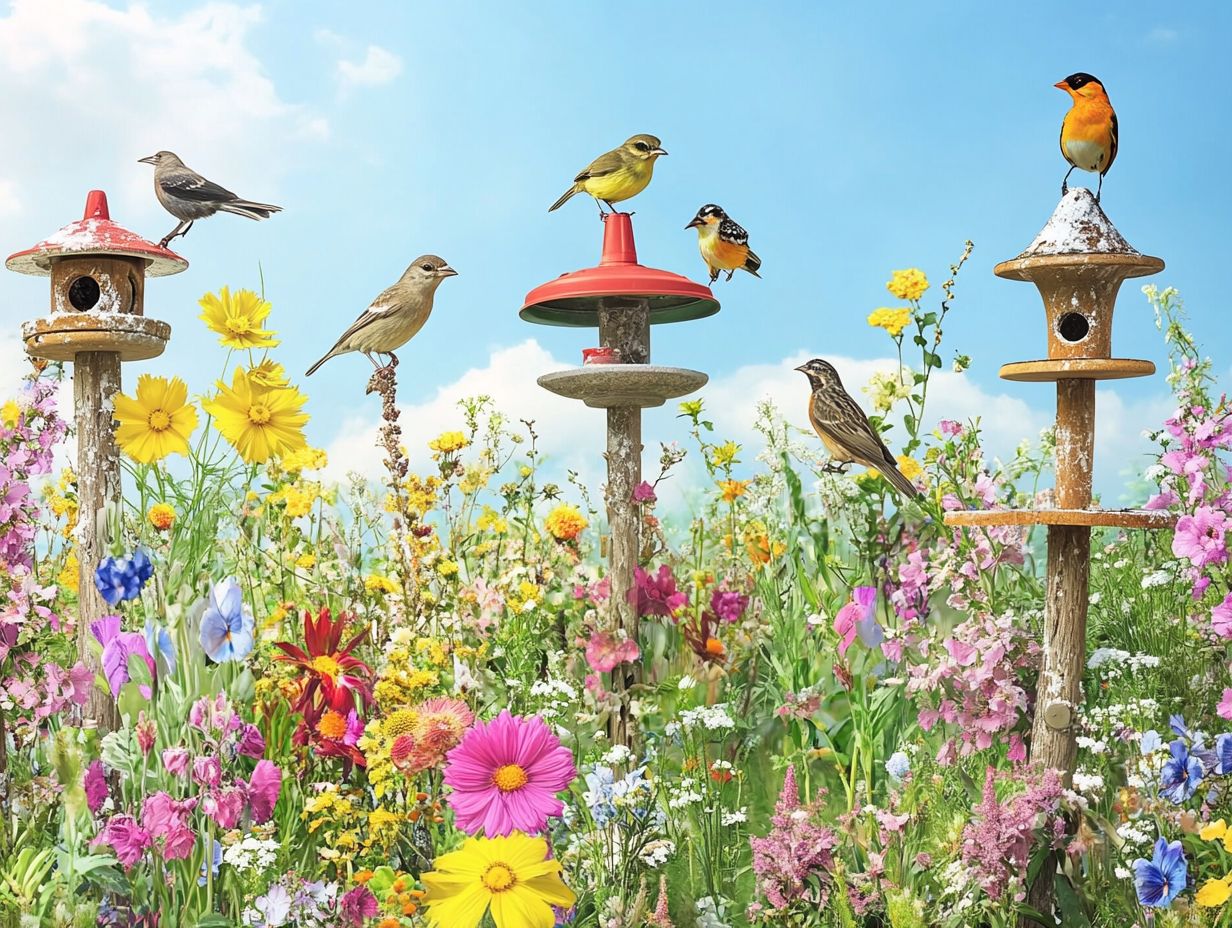
Employing proper maintenance techniques is essential for keeping your birdfeeders functional and effective, especially during harsh weather conditions that require winter-proof feeders.
Regular checks are crucial for assessing the condition of feeders made from various materials like wood, metal, or plastic. For instance, treat wooden feeders with protective coatings to shield them from rain and moisture. Give metal feeders a spray of rust-resistant treatment to maintain their condition.
Adjusting the heights and positions of your feeders can significantly impact attracting birds and shielding them from biting winter winds. Make sure seed ports are clean and free of debris to support a thriving bird community, including chickadees, even during the coldest months.
Frequently Asked Questions
What factors should be considered when choosing the right bird feeder for my area?
Considerations include the types of birds in your area, the weather and climate, and the location of your feeder, especially during National Bird-Feeding Month. For those looking to attract more wildlife, exploring the best bird feeders for large areas can be beneficial.
What type of feeder is best for attracting a variety of birds?
A hopper or platform feeder is ideal for attracting a diverse range of birds since they accommodate different seeds, including sunflower seeds, and are easily accessible for most bird species.
How can I protect my bird feeder from squirrels?
Use a squirrel-resistant feeder or add a baffle to your existing feeder to deter squirrels and other backyard pests like feral cats. Position the feeder at least 10 feet away from trees or other structures to prevent squirrels from reaching it.
What is the best location for my bird feeder?
Place your feeder in a quiet, sheltered spot with some coverage from trees or shrubs. This will provide protection against predators like raccoons and feral cats, allowing birds to feel safe while feeding.
What type of seeds should I use in my bird feeder?
Choose seeds based on the birds in your area. Options include hummingbirds, goldfinches, and fruit feeders. Black oil sunflower seeds are typically a great choice since they are high in fat and attract a variety of bird species.
How often should I clean my bird feeder?
Regular cleaning is vital to prevent the spread of disease among wild birds. Clean your feeder at least once a month and more often during wet or humid conditions.

